Electrostatic Potential and Capacitance - Online Test
Q1. Dielectric polarization is the phenomenon
Answer : Option C
Explaination / Solution:
Atomic dipoles in a dielectric experience a torque when placed in an external electric field. As a result of this torque, they align themselves in the direction of the electric field, since thi is the position of least potential energy. This phenomenon in which the atomic dipoles align themselves in the diorection of the electric field is called dielectric polarization.
Q2. When a capacitor is connected to a battery
Answer : Option B
Explaination / Solution:
When an uncharged capacitor is connected to a battery, charges flow from the poles of the battery to the plates of the capacitor and this process continues till the potential across the capacitor attains the potential difference of the battery. The current flows in the circuit till the time the capacitor is charged and then it ceases.
Q3. The electric field between the plates of a fully charged capacitor is E. If a material of dielectric constant k is introduced between the plates, the electric field at a point between the plates
Answer : Option C
Explaination / Solution:
The capacitance C of a capacitor becomes KC when a dielectric is introduced. ;A fully charged capacitor is the capacitor which is charged and then disconnected from the battery. The charge therefore remains constant, The potential reduces to.The electric field therefore becomes
Q4. The plates of a parallel plate capacitor are 10 cm apart and have area equal to 2m2. If the charge on each plate is , the electric field at a point
Answer : Option A
Explaination / Solution:
The electric field outside two large plates with opposite charge densities will be zero.
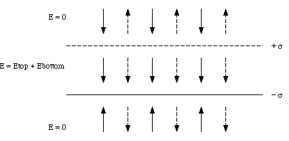
The electric field between the plates of the capacitor
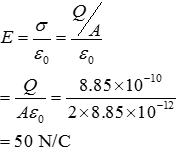
and it is a constant electric field.

The electric field between the plates of the capacitor

and it is a constant electric field.
Q5. The magnitude of the electric field in the annular region of a charged cylindrical capacitor
Answer : Option D
Explaination / Solution:
the electric field at point distance r from the axis of the capacitor and located in the annular region (the region between the two cylinders) of a cylindrical capacitor with linear charge density λ is given by
This field is higher near the inner cylinder.
This field is higher near the inner cylinder.
Q6. If the potential difference between the plates of a capacitor is increased by 0.1%, the energy stored in the capacitor increases by very nearly
Answer : Option C
Explaination / Solution:
The initial energy stored in the capacitor at potential difference V is When the p.d is increased by ,the energy stored is Solving,
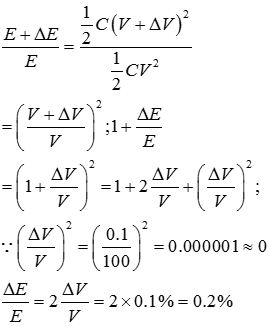

Q7. The effective capacitance of two capacitors of capacitances C1 and C2 (with C2 > C1) connected in parallel is 25/6 times the effective capacitance when they are connected in series. The ratio C2/C1 is
Answer : Option D
Explaination / Solution:
Given , then where k is a constant.
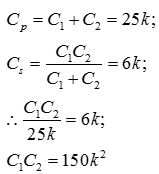
Solving ,

Solving ,
Q8. A parallel plate capacitor of capacitance C is connected to a battery and is charged to a potential difference V. Another capacitor of capacitance 2C is similarly charged to a potential difference 2V. The charging battery is then disconnected and the capacitors are connected in parallel to each other in such a way that the positive terminal of one is connected to the negative terminal of the other. The final energy of the configuration is
Answer : Option D
Explaination / Solution:
The charges Q1 and Q2 on the two capacitors .The capacitors are connected in parallel in such a way that the positive plate of one is connected to the negative plate of the other. The common potential.The final energy
Q9. A parallel combination of 0.1 MΩ resistor and a 10 μF capacitor is connected across a 1.5 V source of negligible resistance. The time (in seconds) required for the capacitor to get charged up to 0.75 V is approximately
Answer : Option A
Explaination / Solution:
A capacitor is charged when the resistance is connected in series with the capacitor. The time constant of the circuit . The capacitor will not be charged.
Q10.
Consider the situation shown in the figure. The capacitor A has a charge q on it whereas B is uncharged. The charge appearing on the capacitor B a long time after the switch is closed is
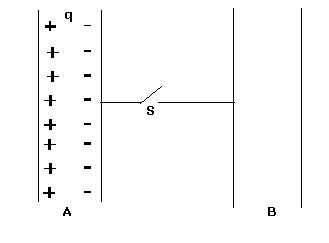

Answer : Option D
Explaination / Solution:
the charge –q is bound to the charge +q. Therefore no charge will appear on the capacitor B. The capacitor B will acquire a charge only if a battery ( driving force) is put in the circuit.
